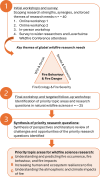Priority research directions for wildfire science: views from a historically fire-prone and an emerging fire-prone country
- PMID: 40241447
- PMCID: PMC12004099
- DOI: 10.1098/rstb.2024.0001
Priority research directions for wildfire science: views from a historically fire-prone and an emerging fire-prone country
Abstract
Fire regimes are changing across the globe, with new wildfire behaviour phenomena and increasing impacts felt, especially in ecosystems without clear adaptations to wildfire. These trends pose significant challenges to the scientific community in understanding and communicating these changes and their implications, particularly where we lack underlying scientific evidence to inform decision-making. Here, we present a perspective on priority directions for wildfire science research-through the lens of academic and government wildfire scientists from a historically wildfire-prone (USA) and emerging wildfire-prone (UK) country. Key topic areas outlined during a series of workshops in 2023 were as follows: (A) understanding and predicting fire occurrence, fire behaviour and fire impacts; (B) increasing human and ecosystem resilience to fire; and (C) understanding the atmospheric and climate impacts of fire. Participants agreed on focused research questions that were seen as priority scientific research gaps. Fire behaviour was identified as a central connecting theme that would allow critical advances to be made across all topic areas. These findings provide one group of perspectives to feed into a more transdisciplinary outline of wildfire research priorities across the diversity of knowledge bases and perspectives that are critical in addressing wildfire research challenges under changing fire regimes.This article is part of the theme issue 'Novel fire regimes under climate changes and human influences: impacts, ecosystem responses and feedbacks'.
Keywords: fire behaviour; fire ecology; fire regimes; global change; research gaps; wildfire.
Conflict of interest statement
We declare we have no competing interests.
Figures


Similar articles
-
Novel wildfire regimes under climate change and human activity: patterns, driving mechanisms and ecological impacts.Philos Trans R Soc Lond B Biol Sci. 2025 Apr;380(1924):20230446. doi: 10.1098/rstb.2023.0446. Epub 2025 Apr 17. Philos Trans R Soc Lond B Biol Sci. 2025. PMID: 40241461 Free PMC article. Review.
-
The use of fire to preserve biodiversity under novel fire regimes.Philos Trans R Soc Lond B Biol Sci. 2025 Apr;380(1924):20230449. doi: 10.1098/rstb.2023.0449. Epub 2025 Apr 17. Philos Trans R Soc Lond B Biol Sci. 2025. PMID: 40241459 Free PMC article.
-
Impacts of Fire-fighting Chemicals on Native Fauna and Ecosystems in Australia: Identification of Key Knowledge Gaps and Research Priorities.Environ Manage. 2025 Jun;75(6):1559-1570. doi: 10.1007/s00267-025-02143-z. Epub 2025 Mar 24. Environ Manage. 2025. PMID: 40128459 Free PMC article.
-
Evidence for widespread changes in the structure, composition, and fire regimes of western North American forests.Ecol Appl. 2021 Dec;31(8):e02431. doi: 10.1002/eap.2431. Epub 2021 Oct 12. Ecol Appl. 2021. PMID: 34339067 Free PMC article.
-
Adapting western North American forests to climate change and wildfires: 10 common questions.Ecol Appl. 2021 Dec;31(8):e02433. doi: 10.1002/eap.2433. Epub 2021 Oct 13. Ecol Appl. 2021. PMID: 34339088 Free PMC article. Review.
Cited by
-
Novel wildfire regimes under climate change and human activity: patterns, driving mechanisms and ecological impacts.Philos Trans R Soc Lond B Biol Sci. 2025 Apr;380(1924):20230446. doi: 10.1098/rstb.2023.0446. Epub 2025 Apr 17. Philos Trans R Soc Lond B Biol Sci. 2025. PMID: 40241461 Free PMC article. Review.
References
-
- Bowman DMJS, Kolden CA, Abatzoglou JT, Johnston FH, van der Werf GR, Flannigan M. 2020. Vegetation fires in the Anthropocene. Nat. Rev. Earth Environ. 1, 500–515. (10.1038/s43017-020-0085-3) - DOI
-
- Chen Y, Hall J, van Wees D, Andela N, Hantson S, Giglio L, van der Werf GR, Morton DC, Randerson JT. 2023. Multi-decadal trends and variability in burned area from the fifth version of the global fire emissions database (GFED5). Earth Syst. Sci. Data 15, 5227–5259. (10.5194/essd-15-5227-2023) - DOI
-
- Jones MW, et al. . 2022. Global and regional trends and drivers of fire under climate change. Rev. Geophys. 60, G000726. (10.1029/2020rg000726) - DOI
-
- AMAP . 2021. Arctic climate change update 2021: key trends and impacts. Summary for policy-makers. pp. 1–16. Arctic Monitoring and Assessment Programme.
MeSH terms
Grants and funding
LinkOut - more resources
Full Text Sources
Medical

